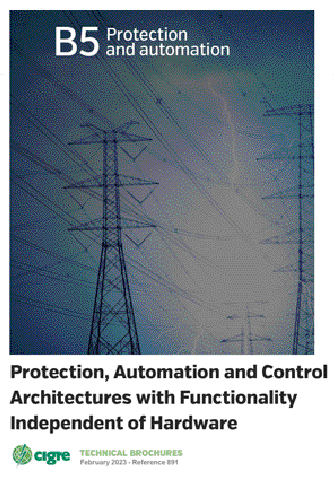(Reviewed by Alex Apostolov, USA)

CIGRE Technical Brochure 891 presents a structured, standards-anchored exploration of how protection, automation and control (PAC) can evolve when application functions are decoupled from hardware, a concept the brochure calls Functionality Independent of Hardware (FIH). The working group (SC B5, WG B5.60) frames the problem briefly: PAC hardware lifecycles (≈10–15 years) lag the much longer lifecycles of primary plant (40–60 years), creating repeated retrofit needs. Separating software functions from device hardware promises portability across platforms, flexible re-allocation, and new redundancy models, while preserving functions for decades despite hardware refreshes.
The brochure opens with an executive summary that defines the expected characteristics of FIH (portability, dynamic assignment, cost-efficient redundancy, generic platforms, and remote engineering opportunities), and previews two architectural paths: (1) IED-based solutions with standardized middleware, and (2) server-based Centralized Protection and Control (CPC) – both leveraging IEC 61850 for information modelling and communication.
Chapters 2–3 provide historical and technical context. Chapter 2 surveys existing PACS architectures and communications, from conventional hardwired schemes to digital substations with process/station-bus segmentation. It summarizes IEC 61850 (data modelling, ACSI/SCSM, MMS, GOOSE, Sampled Values) and details redundant Ethernet strategies (RSTP, PRP, HSR) recommended in digital process-bus designs. The section also describes the logical interfaces between process, bay, and station levels and the move to merging units and process interface units, aligning with IEC 61869 profiles for sampled values. Chapter 3 traces IED architecture evolution through first-, second- and third-generation microprocessor devices, noting shifts in CPUs, A/D performance, operating systems, and software practices that paved the way for multi-functional IEDs and IEC 61850 integration.
Chapter 4 turns FIH into concrete requirements and limitations. It enumerates conditions for free function allocation (granularity, isolation, performance), portability via hardware abstraction, process interfacing (IEC 61869-9/-13 for SV; forthcoming IEC 60255-216-1 for the digital functional chain), time synchronization, interoperability/interchangeability and benchmarking. It also flags EMC/safety product-standard implications when moving beyond traditional IED appliances. Communication design guidance references IEC 61850-90-4 (redundancy, VLANs, multicast filtering) and considers SDN.
Chapter 5 is the technical heart: it formalizes FIH principles (decoupling platform and application, cross-platform data abstraction) and develops two implementation families. The middleware-based IED approach defines a generic hardware platform with standardized interfaces to application containers (vIEDs), while the server-based CPC aggregates protection/control applications on redundant compute, with process interfaces providing digitized measurements/commands illustrated with a reference stack (e.g., LF Energy SEAPATH). Both paths rely on IEC 61850 models to keep engineering portable and tools interoperable.
Chapter 6 addresses engineering processes and tools over the life cycle: software/hardware management, standardized configuration flows (SST/SCT), and a catalogue of maintenance and change operations in virtualized environments adding/removing/migrating vIEDs, rearranging functionality, and platform updates plus testing (design and operational stages), digital twins, and system orchestration/management patterns. These sections make the transition operationally tangible rather than aspirational.
Chapter 7 proposes five reference architectures from IEDs with process bus; IEDs with integrated PIU/multi-feeder; hybrid IED + back-up CPC; CPC with PIU back-up protection; to fully redundant CPC systems and offers a comparison table to weigh performance, resilience, and deployment trade-offs.
This mapping lets utilities align FIH ambitions with risk tolerance and migration constraints.
The closing chapters catalogue technical challenges (test and maintenance processes, cyber/physical security, performance, migration) and business challenges (stakeholder responsibility, skills, vendor relationships, certification, OPEX structure, maintenance model). A final section lists standardization and innovation areas, signaling where committee work is active or needed.
Protection, Automation and Control Architectures with Functionality Independent of Hardware (CIGRE TB 891, 2023)
ISBN 978-2-85873-596-9






